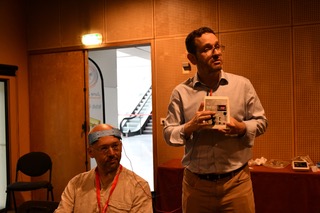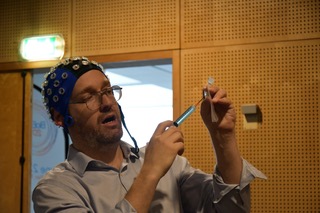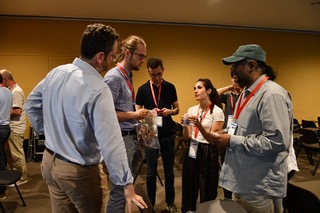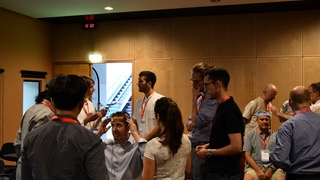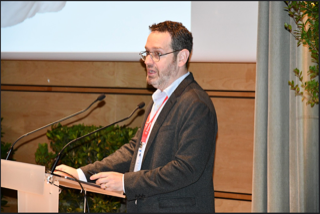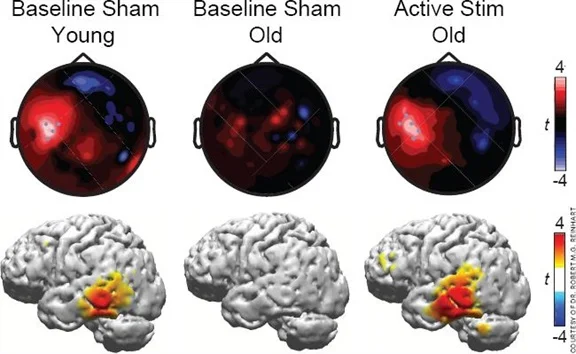Adair, Devin, Dennis Q. Truong, Libby Ho, Bashar W. Badran, Helen Borges, and Marom Bikson. 2019. Abstract #124: How to modulate cognition with cranial nerve stimulation? Brain Stimulation: Basic, Translational, and Clinical Research in Neuromodulation 12 (2) (03/01; 2019/01): e42-3, https://doi.org/10.1016/j.brs.2018.12.131.
Bikson, M. 2019. Downloading personalized brain stimulation. Brain Stimulation: Basic, Translational, and Clinical Research in Neuromodulation 12 (2) (03/01; 2019/01): 424, https://doi.org/10.1016/j.brs.2018.12.375.
Chhatbar, Pratik Y., Steven A. Kautz, Istvan Takacs, Nathan C. Rowland, Gonzalo J. Revuelta, Mark S. George, Marom Bikson, and Wuwei Feng. 2019. Abstract #22: First report of recording transcranial direct current stimulation-generated electric fields in subthalamic nuclei using directional leads. Brain Stimulation: Basic, Translational, and Clinical Research in Neuromodulation 12 (2) (03/01; 2019/01): e8, https://doi.org/10.1016/j.brs.2018.12.029.
DaFonseca, Estevão, Alexandre F. DaSilva, Marom Bikson, Dennis Troung, and Marcos F. DosSantos. 2019. Proceedings #21: Specific patterns of current flow generated by different tDCS montages in the midbrain and in the trigeminal brainstem sensory nuclear complex. Brain Stimulation: Basic, Translational, and Clinical Research in Neuromodulation 12 (2) (03/01; 2019/01): e84-6, https://doi.org/10.1016/j.brs.2018.12.190.
Datta, Abhishek, Yu Huang, Chris Thomas, Marom Bikson, and Ahmed Duke Shereen. 2019. Proceedings #12: Influence of incorporating electrode information from MR images: Towards building more realistic forward models. Brain Stimulation: Basic, Translational, and Clinical Research in Neuromodulation 12 (2) (03/01; 2019/01): e72-4, https://doi.org/10.1016/j.brs.2018.12.181.
Esmaeilpour, Z., M. Jackson, G. Kronberg, T. Zhang, R. Esteller, B. Hershey, and M. Bikson. 2019. Effect of kHz electrical stimulation on hippocampal brain slice excitability and network dynamics. Brain Stimulation: Basic, Translational, and Clinical Research in Neuromodulation 12 (2) (03/01; 2019/01): 586, https://doi.org/10.1016/j.brs.2018.12.948.
Esmaeilpour, Zeinab, Ahmed Duke Shereen, Marom Bikson, and Hamed Ekhtiari. 2019. Abstract #147: MRI neuroimaging methods for tDCS: A methodological note on study design and parameter space. Brain Stimulation: Basic, Translational, and Clinical Research in Neuromodulation 12 (2) (03/01; 2019/01): e50, https://doi.org/10.1016/j.brs.2018.12.154.
Fallahrad, Mohamad, Louis Zannou, Niranjan Khadka, Steven A. Prescott, Stéphanie Ratté, Tianhe Zhang, Rosana Esteller, Brad Hershey, and Marom Bikson. 2019. Abstract #159: Hardware suitable for electrophysiology and stimulation in kHz range. Brain Stimulation: Basic, Translational, and Clinical Research in Neuromodulation 12 (2) (03/01; 2019/01): e54, https://doi.org/10.1016/j.brs.2018.12.166.
Favoretto, Diandra B., Eduardo Bergonzoni, Diego Nascimento, Brunna Rimoli, Tenysson Will-Lemos, Dennis Q. Truong, Renato Moraes, et al. 2019. Abstract #119: Polarity-dependent effects on postural control after high-definition transcranial direct current stimulation over the temporo-parietal junction. Brain Stimulation: Basic, Translational, and Clinical Research in Neuromodulation 12 (2) (03/01; 2019/01): e41, https://doi.org/10.1016/j.brs.2018.12.126.
Fonteneau, Clara, Marine Mondino, Martijn Arns, Chris Baeken, Marom Bikson, Andre R. Brunoni, Matthew J. Burke, et al. Sham tDCS: A hidden source of variability? reflections for further blinded, controlled trials. Brain Stimulation: Basic, Translational, and Clinical Research in Neuromodulation (2019/01), https://doi.org/10.1016/j.brs.2018.12.977.
Gebodh, Nigel, Zeinab Esmaeilpour, Devin Adair, Kenneth Chelette, Jacek Dmochowski, Lucas Parra, Adam J. Woods, Emily S. Kappenman, and Marom Bikson. 2019. Abstract #125: Failure of conventional signal processing techniques to remove “Physiological” artifacts from EEG during tDCS. Brain Stimulation: Basic, Translational, and Clinical Research in Neuromodulation 12 (2) (03/01; 2019/01): e43, https://doi.org/10.1016/j.brs.2018.12.132.
Gebodh, Nigel, Laura Vacchi, Devin Adair, Gozde Unal, Alexander Poltorak, Valeria Poltorak, and Marom Bikson. 2019. Proceedings #11: Replay of endogenous sleep rhythms to produce sleepiness. Brain Stimulation: Basic, Translational, and Clinical Research in Neuromodulation 12 (2) (03/01; 2019/01): e71-2, https://doi.org/10.1016/j.brs.2018.12.180.
Huang, Y., A. Datta, M. Bikson, and L. Parra. 2019. ROAST: A fully-automated, open-source, realistic vOlumetric-approach-based simulator for TES. Brain Stimulation: Basic, Translational, and Clinical Research in Neuromodulation 12 (2) (03/01; 2019/01): 391, https://doi.org/10.1016/j.brs.2018.12.253.
Huang, Y., and L. Parra. 2019. Deep brain areas can be reached by transcranial electric stimulation with multiple electrodes. Brain Stimulation: Basic, Translational, and Clinical Research in Neuromodulation 12 (2) (03/01; 2019/01): 390-1, https://doi.org/10.1016/j.brs.2018.12.252.
Huang, Yu, Chris Thomas, Abhishek Datta, and Lucas C. Parra. 2019. Proceedings #23: Inaccurate segmentation of lesioned brains can significantly affect targeted transcranial electrical stimulation on stroke patients. Brain Stimulation: Basic, Translational, and Clinical Research in Neuromodulation 12 (2) (03/01; 2019/01): e87-9, https://doi.org/10.1016/j.brs.2018.12.192.
Jiang, Jimmy, Dennis Q. Truong, and Marom Bikson. 2019. Abstract #115: What is theoretically more focal: HD-tDCS or TMS? Brain Stimulation: Basic, Translational, and Clinical Research in Neuromodulation 12 (2) (03/01; 2019/01): e39-40, https://doi.org/10.1016/j.brs.2018.12.122.
Jiang, Jimmy, Dennis Q. Truong, Yu Huang, Lucas Parra, and Marom Bikson. 2019. Abstract #118: Transcranial electrical stimulation models using an emulated-CSF value approximate the meninges more accurately. Brain Stimulation: Basic, Translational, and Clinical Research in Neuromodulation 12 (2) (03/01; 2019/01): e40-1, https://doi.org/10.1016/j.brs.2018.12.125.
Khadka, N., A. Zannou, D. Truong, T. Zhang, R. Esteller, B. Hersey, and M. Bikson. 2019. Generation 2 kilohertz spinal cord stimulation (kHz-SCS) bioheat multi-physics model. Brain Stimulation: Basic, Translational, and Clinical Research in Neuromodulation 12 (2) (03/01; 2019/01): 566, https://doi.org/10.1016/j.brs.2018.12.876.
Khadka, Niranjan, Helen Borges, Trynia Kauffman, Alain Pascal, Bhaskar Paneri, Electra Nassis, Yungjae Shin, et al. 2019. Abstract #109: Tolerability of an adaptive-tDCS upto 4 mA using subject assessment and machine-learning to optimize dose. Brain Stimulation: Basic, Translational, and Clinical Research in Neuromodulation 12 (2) (03/01; 2019/01): e37-8, https://doi.org/10.1016/j.brs.2018.12.116.
Khadka, Niranjan, Helen Borges, Adantchede L. Zannou, Jongmin Jang, Byungjik Kim, Kiwon Lee, and Marom Bikson. 2019. Abstract #100: Dry tDCS: Tolerability of a novel multilayer hydrogel composite non-adhesive electrode for tDCS. Brain Stimulation: Basic, Translational, and Clinical Research in Neuromodulation 12 (2) (03/01; 2019/01): e35, https://doi.org/10.1016/j.brs.2018.12.107.
Kronberg, G., A. Rahman, M. Bikson, and L. Parra. 2019. A hebbian framework for predicting modulation of synaptic plasticity with tDCS. Brain Stimulation: Basic, Translational, and Clinical Research in Neuromodulation 12 (2) (03/01; 2019/01): 554, https://doi.org/10.1016/j.brs.2018.12.831.
Kronberg, Greg, Asif Rahman, Marom Bikson, and Lucas Parra. 2019. Abstract #122: A hebbian framework for predicting modulation of synaptic plasticity with tDCS. Brain Stimulation: Basic, Translational, and Clinical Research in Neuromodulation 12 (2) (03/01; 2019/01): e42, https://doi.org/10.1016/j.brs.2018.12.129.
Louviot, Samuel, Jacek Dmochowski, Jacques Jonas, Louis Maillard, Sophie Colnat-Coulbois, Louise Tyvaert, and Laurent Koessler. 2019. Abstract #32: Medial and lateral temporal lobe neuromodulation in epilepsy: A simultaneous tdcs-seeg investigation. Brain Stimulation: Basic, Translational, and Clinical Research in Neuromodulation 12 (2) (03/01; 2019/01): e12, https://doi.org/10.1016/j.brs.2018.12.039.
Louviot, Samuel, Jacek Dmochowski, Jacques Jonas, Louis Maillard, Sophie Colnat-Coulbois, Louise Tyvaert, and Laurent koessler. 2019. Abstract #68: A human in-vivo evaluation of roast using simultaneous intracerebral electrical stimulations and scalp eeg. Brain Stimulation: Basic, Translational, and Clinical Research in Neuromodulation 12 (2) (03/01; 2019/01): e24, https://doi.org/10.1016/j.brs.2018.12.075.
Lucas Parra, Yu Huang. 2019. Abstract #38: Transcranial electric stimulation with multiple electrodes can reach deep brain areas. Brain Stimulation: Basic, Translational, and Clinical Research in Neuromodulation 12 (2) (03/01; 2019/01): e14, https://doi.org/10.1016/j.brs.2018.12.045.
Meiron, Oded, Rena Gale, Julia Namestnic, Odeya Bennet-Back, Jonathan David, Nigel Gebodh, Devin Adair, Zeinab Esmaeilpour, and Marom Bikson. 2019. Abstract #123: Attenuation of pathological EEG features in nonatal electroclinical syndromes: HD-tDCS in catastrophic epilepsies. Brain Stimulation: Basic, Translational, and Clinical Research in Neuromodulation 12 (2) (03/01; 2019/01): e42, https://doi.org/10.1016/j.brs.2018.12.130.
Mourdoukoutas, Antonios, Gozde Unal, John Martin, Mar Cortes, Jeremy Fidock, and Marom Bikson. 2019. Proceedings #14: Neuromodulation of spinal cord with tDCS extracephalic return electrode. Brain Stimulation: Basic, Translational, and Clinical Research in Neuromodulation 12 (2) (03/01; 2019/01): e75-6, https://doi.org/10.1016/j.brs.2018.12.183.
Quinn, Davin, Joel Upston, Thomas Jones, Jessica Richardson, Lindsay Worth, Violet Fratzke, Julia Stephen, et al. 2019. Abstract #1: Individualizing HD-tDCS with fMRI and E-field modeling: Pilot data from the NAVIGATE-TBI study. Brain Stimulation: Basic, Translational, and Clinical Research in Neuromodulation 12 (2) (03/01; 2019/01): e1, https://doi.org/10.1016/j.brs.2018.12.008.
Salvi, Carola, Ryan D. Conrardy, Marom Bikson, Mark Beeman, and Jordan Grafman. 2019. Abstract #142: Effects of high definition tDCS on problem solving networks. Brain Stimulation: Basic, Translational, and Clinical Research in Neuromodulation 12 (2) (03/01; 2019/01): e49, https://doi.org/10.1016/j.brs.2018.12.149.
Shaw, M., N. Pawlak, C. Choi, N. Khan, A. Datta, and M. Bikson. 2019. Transcranial direct current stimulation (tDCS) induces acute changes in brain metabolism. Brain Stimulation: Basic, Translational, and Clinical Research in Neuromodulation 12 (2) (03/01; 2019/01): 518, https://doi.org/10.1016/j.brs.2018.12.703.
Shereen, D., and L. Parra. 2019. Rapid measurement of electromagnetic fields induced from transcranial electric stimulation using magnetic resonance imaging. Brain Stimulation: Basic, Translational, and Clinical Research in Neuromodulation 12 (2) (03/01; 2019/01): 584, https://doi.org/10.1016/j.brs.2018.12.938.
Shereen, Duke, and Lucas Parra. 2019. Abstract #98: Rapid field mapping using magnetic resonance imaging during transcranial direct current stimulation. Brain Stimulation: Basic, Translational, and Clinical Research in Neuromodulation 12 (2) (03/01; 2019/01): e34, https://doi.org/10.1016/j.brs.2018.12.105.
Tarbell, John, Marom Bikson, Limary M. Cancel, and Niranjan Khadka. 2019. Abstract #33: Direct current stimulation of endothelial monolayers induces an increase in transport by the electroosmotic effect. Brain Stimulation: Basic, Translational, and Clinical Research in Neuromodulation 12 (2) (03/01; 2019/01): e12, https://doi.org/10.1016/j.brs.2018.12.040.
Trapp, Nicholas T., Willa Xiong, Britt M. Gott, Gemma D. Espejo, Marom Bikson, and Charles R. Conway. 2019. Proceedings #51: 4 mA adaptive transcranial direct current stimulation for treatment-resistant depression: Early demonstration of feasibility with a 20-session course. Brain Stimulation: Basic, Translational, and Clinical Research in Neuromodulation 12 (2) (03/01; 2019/01): e124-5, https://doi.org/10.1016/j.brs.2018.12.220.
Truong, Dennis Q., Catherine Maglione, Yishai Valter, Louis Zannou, A. D. Shereen, Preston Williams, John H. Martin, and Marom Bikson. 2019. Abstract #29: Scaling spinal cord injury models for non-invasive stimulation. Brain Stimulation: Basic, Translational, and Clinical Research in Neuromodulation 12 (2) (03/01; 2019/01): e10-1, https://doi.org/10.1016/j.brs.2018.12.036.
Unal, Gozde, Bronte N. Ficek, Kimberly T. Webster, Syed Shahabuddin, Dennis Q. Truong, Marom Bikson, and Kyrana Tsapkini. 2019. Abstract #113: Individualized modeling for subjects with primary progressive aphasia. Brain Stimulation: Basic, Translational, and Clinical Research in Neuromodulation 12 (2) (03/01; 2019/01): e39, https://doi.org/10.1016/j.brs.2018.12.120.
Valero-Cabre, Antoni, Clara Sanches, Dennis Q. Truong, Marom Bikson, and Marc Teichmann. 2019. Abstract #2: Improvement of language function following prefrontal transcranial direct current brain stimulation in progressive supranuclear palsy. Brain Stimulation: Basic, Translational, and Clinical Research in Neuromodulation 12 (2) (03/01; 2019/01): e1-2, https://doi.org/10.1016/j.brs.2018.12.009.
Williams, Preston, John Brandenburg, Dennis Q. Truong, Alan C. Seifert, Adrish Sarkar, Junqian Xu, Marom Bikson, and John Martin. 2019. Abstract #136: Translational neuromodulation of motor-output using trans-spinal direct current stimulation (tsDCS) in a large animal model. Brain Stimulation: Basic, Translational, and Clinical Research in Neuromodulation 12 (2) (03/01; 2019/01): e46-7, https://doi.org/10.1016/j.brs.2018.12.143.
Zannou, Adantchede L., Niranjan Khadka, Mohamad FallahRad, Dennis Truong, and Marom Bikson. 2019. Abstract #30: Tissue temperature increases by HF10 senza spinal cord stimulation system: Phantom and bioheat model. Brain Stimulation: Basic, Translational, and Clinical Research in Neuromodulation 12 (2) (03/01; 2019/01): e11, https://doi.org/10.1016/j.brs.2018.12.037.







